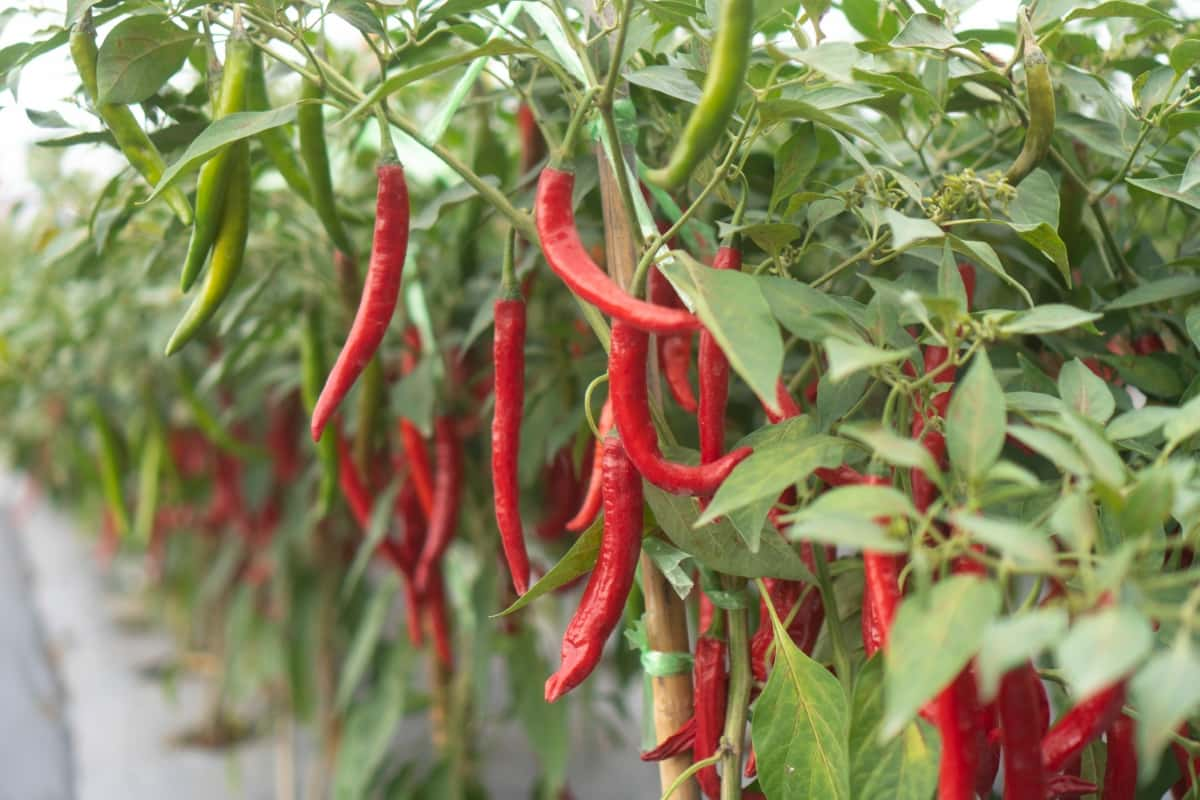Welcome, fellow gardeners and farmers, to our insightful journey into the world of chili plant cultivation! Are you tired of battling relentless insect pests that threaten to diminish your hard-earned profits? Fear not, for we have assembled a comprehensive guide showcasing the best and latest pesticides tailored specifically for chili plants.

By harnessing the power of cutting-edge solutions, we can effectively control insect pests, ensuring healthier and more bountiful chili crops. Join us as we delve into this engaging and creative exploration, backed by accurate data, to help you achieve better profits and safeguard your chili plants from pesky intruders.
Latest Pesticide for Chilli Plants
What are Pesticides?
Pesticides are chemical substances used to control pests that harm crops. They play a vital role in safeguarding plant health and maximizing agricultural yields. Pesticides come in various forms, including sprays, powders, and granules, and they work by either repelling or killing pests. With precise application, these powerful tools can significantly reduce insect damage and enhance crop productivity, ensuring a stable and abundant food supply for our growing population.
Benefits of Pesticide for Chilli Plants
Pesticides are indispensable for the health and productivity of chilli plants. They combat insect pests, protecting plants and maximizing yields. These chemical solutions, including herbicides, fungicides, and insecticides, cater to organic and conventional farming. Since the 1940s, pesticides have gained prominence for their targeted effectiveness.
They contribute to sustainability by reducing crop losses, minimizing the need for additional land and resources, and conserving habitats. Pesticides also play a vital role in preventing the transmission of plant diseases. When used responsibly, following guidelines and safety precautions, pesticides offer reliable protection throughout the growth cycle, ensuring optimal chilli plant cultivation while minimizing environmental and health risks.
When to Apply Pesticide for Chilli Plants?
Timing is important when it comes to applying pesticides for chili plants. To effectively combat pests and prevent damage, it is recommended to apply pesticides when pests are detected. Acting promptly will help safeguard your plants from potential harm. It is advisable to apply pesticides before any visible damage occurs to your plants and before pests can spread to neighboring plants.
Ensuring pesticides are applied correctly to eradicate infestations without harming the crop. Target the application during the night when pests are least active for optimal results. This strategy minimizes their ability to escape the spray and reduces their long-term resistance to pesticides through selective breeding.
How to Apply Pesticide for Chilli Plants
- Carefully read and understand the instructions on the pesticide label. Some products may require protective gear like masks, gloves, and eye protection. Prioritize safety by adhering to these guidelines.
- If possible, utilize a sprayer for application. This helps minimize drift and enables better control over the amount of pesticide being used. Applying the pesticide sparingly without a sprayer to avoid over-application on foliage or soil can lead to runoff and potential environmental impact.
- Take into account wind conditions. Avoid applying pesticides when wind speeds exceed 30 km/hr, as it increases the risk of unintended effects and inhalation exposure to harmful chemicals.
How Often to Apply Pesticide for Chilli Plants
A recommended practice for chili plants is to apply pesticides once a month, ensuring consistent pest protection. Optimal application times are during the morning or evening to minimize degradation and reduce plant harm. Regardless of pesticide type, wearing protective gloves and eyewear is vital to safeguard against contact and promote safety.
Latest Pesticides for Chilli Crop with Brand
Insecticides
Acephate 75% SP (Ace – Coromandel)
- Dosage: 300 gm/acre or 1.5 gm/lt water.
- Effective against thrips and leaf curl virus. Causes include the curling of leaves upward.
Emamectin benzoate 5% SG (Lepto – Atul Crop care)
- Dosage: 80 gm/acre.
- Controls thrips and mites. Suitable for treating downward curling of leaves.
Thiamethoxam 30% FS (Spora Super – Atul Crop care)
- Dosage: 1 ml/kg seed (seed treatment).
- Effective against thrips and aphids.
Fipronil 5% SC (Reagent – Bayer)
- Dosage: 400 ml/acre or 2 ml/lt water.
- Controls thrips, whitefly, and other pests.
Spinosad 45% SC (Taffin – Tata Rallis)
- Dosage: 100 ml/acre or 0.5 ml/lt water.
- Effective against thrips and mites.
Fungicides
Copper oxychloride 50% WP (Tamrak – Coromandel)
- Dosage: 600 gm/acre or 3 gm/lt water.
- Controls damping-off disease. Used for soil drenching.
Tebuconazole 25.9% EC (Folicur – Bayer)
- Dosage: 200 ml/acre or 1 ml/lt water.
- Effective against damping-off disease.
Azoxystrobin 18.2% + Difenoconazole 11.4% SC (Prabhavi – Atul Crop care)
- Dosage: 200 ml/acre.
- Controls anthracnose.
Chlorothalonil 75% WP (Ishaan – Rallis)
- Dosage: 400 gm/acre or 2 gm/lt water.
- Effective against bacterial leaf spots and fruit rot.
Note: Always follow the recommended dosages and application methods the manufacturer mentions. Maintaining adequate moisture and taking necessary precautions while handling pesticides are important.
In case you missed it: How to Prevent Aflatoxins in Chilli Farming

Pesticides for Chilli Crop: Target Pests, Dosage, Mode of Application
Acephate
- Targeted Insect Pest: Aphids, whiteflies, thrips.
- State: Granular or liquid.
- Dosage: 1 gram per liter of water (granular), 2 milliliters per liter of water (liquid).
- Mode of Application: Foliar spray.
- Recommended Interval: Every 10-14 days.
Spinosad
- Targeted Insect Pest: Thrips, leafminers, caterpillars.
- State: Liquid concentrate.
- Dosage: 2-4 milliliters per liter of water.
- Mode of Application: Foliar spray.
- Recommended Interval: Every 7-10 days.
Imidacloprid
- Targeted Insect Pest: Aphids, whiteflies, leafhoppers.
- State: Granular or liquid.
- Dosage: 0.5-1 gram per liter of water (granular), 1 milliliter per liter of water (liquid).
- Mode of Application: Soil drench or foliar spray.
- Recommended Interval: Every 14-21 days.
Bifenthrin
- Targeted Insect Pest: Aphids, thrips, mites.
- State: Liquid concentrate.
- Dosage: 2-4 milliliters per liter of water.
- Mode of Application: Foliar spray.
- Recommended Interval: Every 7-14 days.
Carbaryl
- Targeted Insect Pest: Caterpillars, beetles, aphids.
- State: Liquid concentrate.
- Dosage: 2-4 milliliters per liter of water.
- Mode of Application: Foliar spray.
- Recommended Interval: Every 7-14 days.
Lambda-cyhalothrin
- Targeted Insect Pest: Aphids, leafminers, thrips.
- State: Liquid concentrate.
- Dosage: 1-2 milliliters per liter of water.
- Mode of Application: Foliar spray.
- Recommended Interval: Every 7-14 days.
Chlorpyrifos
- Targeted Insect Pest: Aphids, leafhoppers, whiteflies.
- State: Liquid concentrate.
- Dosage: 2-4 milliliters per liter of water.
- Mode of Application: Foliar spray.
- Recommended Interval: Every 7-14 days.
Cypermethrin
- Targeted Insect Pest: Aphids, thrips, leafminers.
- State: Liquid concentrate.
- Dosage: 2-4 milliliters per liter of water.
- Mode of Application: Foliar spray.
- Recommended Interval: Every 7-14 days.
Azadirachtin
- Targeted Insect Pest: Aphids, whiteflies, spider mites.
- State: Liquid concentrate.
- Dosage: 2-4 milliliters per liter of water.
- Mode of Application: Foliar spray.
- Recommended Interval: Every 7-10 days.
Fenpropathrin
- Targeted Insect Pest: Thrips, aphids, spider mites.
- State: Liquid concentrate.
- Dosage: 2-4 milliliters per liter of water.
- Mode of Application: Foliar spray.
- Recommended Interval: Every 7-14 days.
Deltamethrin
- Targeted Insect Pest: Aphids, thrips, caterpillars.
- State: Liquid concentrate.
- Dosage: 1-2 milliliters per liter of water.
- Mode of Application: Foliar spray.
- Recommended Interval: Every 7-14 days.
Acequinocyl
- Targeted Insect Pest: Spider mites, thrips, whiteflies.
- State: Liquid concentrate.
- Dosage: 2-4 milliliters per liter of water.
- Mode of Application: Foliar spray.
- Recommended Interval: Every 7-10 days.
Pyrethrin
- Targeted Insect Pest: Aphids, caterpillars, beetles.
- State: Liquid concentrate.
- Dosage: 2-4 milliliters per liter of water.
- Mode of Application: Foliar spray.
- Recommended Interval: Every 7-14 days.
Propoxur
- Targeted Insect Pest: Aphids, thrips, whiteflies.
- State: Granular or liquid.
- Dosage: 0.5-1 gram per liter of water (granular), 1 milliliter per liter of water (liquid).
- Mode of Application: Soil drench or foliar spray.
- Recommended Interval: Every 14-21 days.
Thiamethoxam
- Targeted Insect Pest: Aphids, whiteflies, leafhoppers.
- State: Granular or liquid.
- Dosage: 0.5-1 gram per liter of water (granular), 1 milliliter per liter of water (liquid).
- Mode of Application: Soil drench or foliar spray.
- Recommended Interval: Every 14-21 days.
Note: Remember to read and follow the instructions on the pesticide label, including dosage rates, application methods, and safety precautions. Handling pesticides responsibly and in accordance with local regulations is crucial to ensure effective pest control and environmental safety.
In case you missed it: How to Grow Bird’s Eye Chili from Seed: A Step-By-Step Guide for Planting to Harvest

Conclusions
For better profits and effective control of insect pests in chilli plants, the latest and best pesticides include Acephate, Emamectin benzoate, Thiamethoxam, Fipronil, and Spinosad for insects. Following recommended dosages and application methods will help ensure successful pest management and higher crop yields.
- Feed Your Flock for Less: Top 10 Tips to Save on Chicken Feed
- Ultimate Guide to Ossabaw Island Hog: Breeding, Raising, Diet, and Care
- Hatching Answers: The Top 10 Reasons Your Chickens Aren’t Laying Eggs
- Eggs and Economics: Breaking Down the Cost of Raising Backyard Chickens
- Defend Your Greens: Proven Methods to Keep Iguanas Out of Your Garden
- Ultimate Guide to Cinnamon Queen Chicken: A Comprehensive Guide for Beginners
- Ultimate Guide to California Tan Chicken: Breeding, Raising, Diet, Egg-Production and Care
- Ultimate Guide to Marsh Daisy Chicken: Breeding, Raising, Diet, and Care
- 10 Types of Chicken Farming Businesses You Can Start for Profits